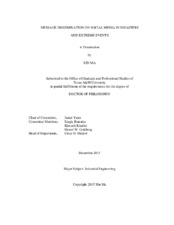| dc.description.abstract | In recent years, there has been an increasing use of social media in disseminating emergency messages to the public by various governmental and non-governmental emergency management organizations and agencies. These messages, including alerts, warnings and updates, carry important event-related information that helps improve individuals’ situational awareness and decision making before, during and after an event. Therefore, wide and timely dissemination of these messages among the public especially the population at risk will be a key for successful emergency preparedness, response, and recovery. However, there is too little knowledge about the impact of social media message propagation on individual message reception as well as the identification of strategies to facilitate message dissemination under the complex environments in disasters and extreme events.
This research was motivated by these facts and takes a first step to conduct quantitative analysis on social media messaging strategies for emergency management organizations and agencies. Specifically, it examines the message propagation process on social media networks and explores message targeting strategies under the constraints of the length of planning horizon, source messaging capability as well as network structure and conditions. Three message dissemination scenarios are studied, including a single-network single-message scenario, a single-network multi-message scenario, and a multi-network multi-message scenario. The impacts of various factors on message dissemination outcomes and targeting decision making are examined through computational experiments on smaller-scale random and Twitter networks. Results and implications for real-world applications are discussed.
This research contributes to the theory and application of social media use in emergency communication mainly in three aspects. First, it summarizes the mainstream literature on this topic and points out the research need for social media messaging strategies for emergency management organizations and agencies in disasters and extreme events. Second, it conceptualizes the problem, develops three message dissemination application scenarios, and provides discrete optimization models for each of them. Third, it conducts extensive computational experiments on small-scale random and Twitter networks to verify the models and study their performance. The implications derived from the results provide valuable insights for emergency management organizations and agencies in developing social media messaging strategies in the real-world applications. | en |


